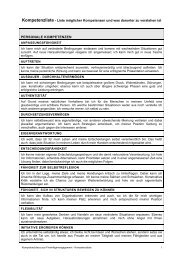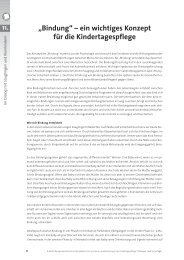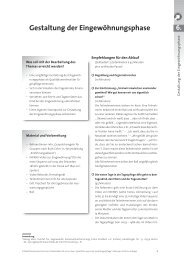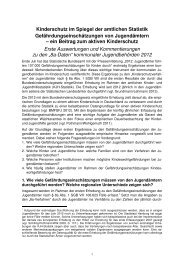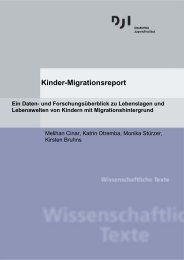Assessing the effects of informal learning on occupational compe ...
Assessing the effects of informal learning on occupational compe ...
Assessing the effects of informal learning on occupational compe ...
Create successful ePaper yourself
Turn your PDF publications into a flip-book with our unique Google optimized e-Paper software.
1 Statement <str<strong>on</strong>g>of</str<strong>on</strong>g> <str<strong>on</strong>g>the</str<strong>on</strong>g> problem<br />
Procedures for establishing occupati<strong>on</strong>al <strong>compe</strong>tence, such as <str<strong>on</strong>g>the</str<strong>on</strong>g><br />
Assessment Centre (AC) procedure, are systematic and standardized tools<br />
for recording and measuring multidimensi<strong>on</strong>al <strong>compe</strong>tences and potentials<br />
(e.g., in specialist knowledge, behavioural achievements and deficits, and<br />
pers<strong>on</strong>ality characteristics) in which <str<strong>on</strong>g>the</str<strong>on</strong>g> aim is to allow differentiated and<br />
optimized pers<strong>on</strong>nel planning. In accordance with <str<strong>on</strong>g>the</str<strong>on</strong>g>se objectives, <str<strong>on</strong>g>the</str<strong>on</strong>g>se<br />
procedures are traditi<strong>on</strong>ally applied by companies and organizati<strong>on</strong>s during<br />
<str<strong>on</strong>g>the</str<strong>on</strong>g> selecti<strong>on</strong> and posting <str<strong>on</strong>g>of</str<strong>on</strong>g> pers<strong>on</strong>nel.<br />
Procedures <str<strong>on</strong>g>of</str<strong>on</strong>g> this type have also increasingly been used for some time in<br />
<str<strong>on</strong>g>the</str<strong>on</strong>g> area <str<strong>on</strong>g>of</str<strong>on</strong>g> <str<strong>on</strong>g>the</str<strong>on</strong>g> assistance provided for disadvantaged individuals during <str<strong>on</strong>g>the</str<strong>on</strong>g><br />
transiti<strong>on</strong> between school and occupati<strong>on</strong>, in order to allow more effective,<br />
more suitable, and better targeted individual vocati<strong>on</strong>al preparati<strong>on</strong> and training.<br />
With suitable and appropriate test procedures, young people should be<br />
enabled to recognize <str<strong>on</strong>g>the</str<strong>on</strong>g>ir own <strong>compe</strong>tences and skills and use <str<strong>on</strong>g>the</str<strong>on</strong>g>m in <str<strong>on</strong>g>the</str<strong>on</strong>g>ir<br />
future occupati<strong>on</strong>s. Teachers, trainers, and o<str<strong>on</strong>g>the</str<strong>on</strong>g>r specialists working with<br />
young people <str<strong>on</strong>g>of</str<strong>on</strong>g> this type should be able to recognize <strong>compe</strong>tences <str<strong>on</strong>g>of</str<strong>on</strong>g> <str<strong>on</strong>g>the</str<strong>on</strong>g><br />
young people that have previously remained hidden and disregarded and use<br />
<str<strong>on</strong>g>the</str<strong>on</strong>g>m for <str<strong>on</strong>g>the</str<strong>on</strong>g>ir individual educati<strong>on</strong> and training.<br />
However, traditi<strong>on</strong>al pers<strong>on</strong>nel and aptitude diagnostic tests, such as <str<strong>on</strong>g>the</str<strong>on</strong>g><br />
Assessment Centre (AC) procedure, neglect <str<strong>on</strong>g>the</str<strong>on</strong>g> individual (social) <strong>compe</strong>tences<br />
that young people acquire through <str<strong>on</strong>g>informal</str<strong>on</strong>g> <str<strong>on</strong>g>learning</str<strong>on</strong>g> outside <str<strong>on</strong>g>the</str<strong>on</strong>g> formal<br />
educati<strong>on</strong>al system. Instead, <str<strong>on</strong>g>the</str<strong>on</strong>g>y <str<strong>on</strong>g>of</str<strong>on</strong>g>ten measure and certify <str<strong>on</strong>g>the</str<strong>on</strong>g> cognitive<br />
achievements or deficits (particularly in school performance) that are<br />
resp<strong>on</strong>sible for <str<strong>on</strong>g>the</str<strong>on</strong>g>se young people having been stigmatized as ‘disadvantaged<br />
young people’. The aim in <strong>compe</strong>tence assessment procedures in <str<strong>on</strong>g>the</str<strong>on</strong>g><br />
field <str<strong>on</strong>g>of</str<strong>on</strong>g> assistance for <str<strong>on</strong>g>the</str<strong>on</strong>g> disadvantaged is to avoid this mistake and <str<strong>on</strong>g>the</str<strong>on</strong>g>refore<br />
attempt to c<strong>on</strong>duct measurements at o<str<strong>on</strong>g>the</str<strong>on</strong>g>r levels and reach a differentiated<br />
and more comprehensive <strong>compe</strong>tence pr<str<strong>on</strong>g>of</str<strong>on</strong>g>ile based <strong>on</strong> young people’s<br />
strengths (<str<strong>on</strong>g>the</str<strong>on</strong>g> empowerment c<strong>on</strong>cept), which are <str<strong>on</strong>g>of</str<strong>on</strong>g>ten not taken into<br />
account in traditi<strong>on</strong>al pers<strong>on</strong>nel and aptitude diagnostic procedures <str<strong>on</strong>g>of</str<strong>on</strong>g> <str<strong>on</strong>g>the</str<strong>on</strong>g><br />
type <str<strong>on</strong>g>of</str<strong>on</strong>g>ten used by companies when testing prospective employees.<br />
5 <str<strong>on</strong>g>Assessing</str<strong>on</strong>g> <str<strong>on</strong>g>the</str<strong>on</strong>g> <str<strong>on</strong>g>effects</str<strong>on</strong>g> <str<strong>on</strong>g>of</str<strong>on</strong>g> <str<strong>on</strong>g>informal</str<strong>on</strong>g> <str<strong>on</strong>g>learning</str<strong>on</strong>g> <strong>on</strong> occupati<strong>on</strong>al <strong>compe</strong>tences <str<strong>on</strong>g>of</str<strong>on</strong>g> disadvantaged young pers<strong>on</strong>s





